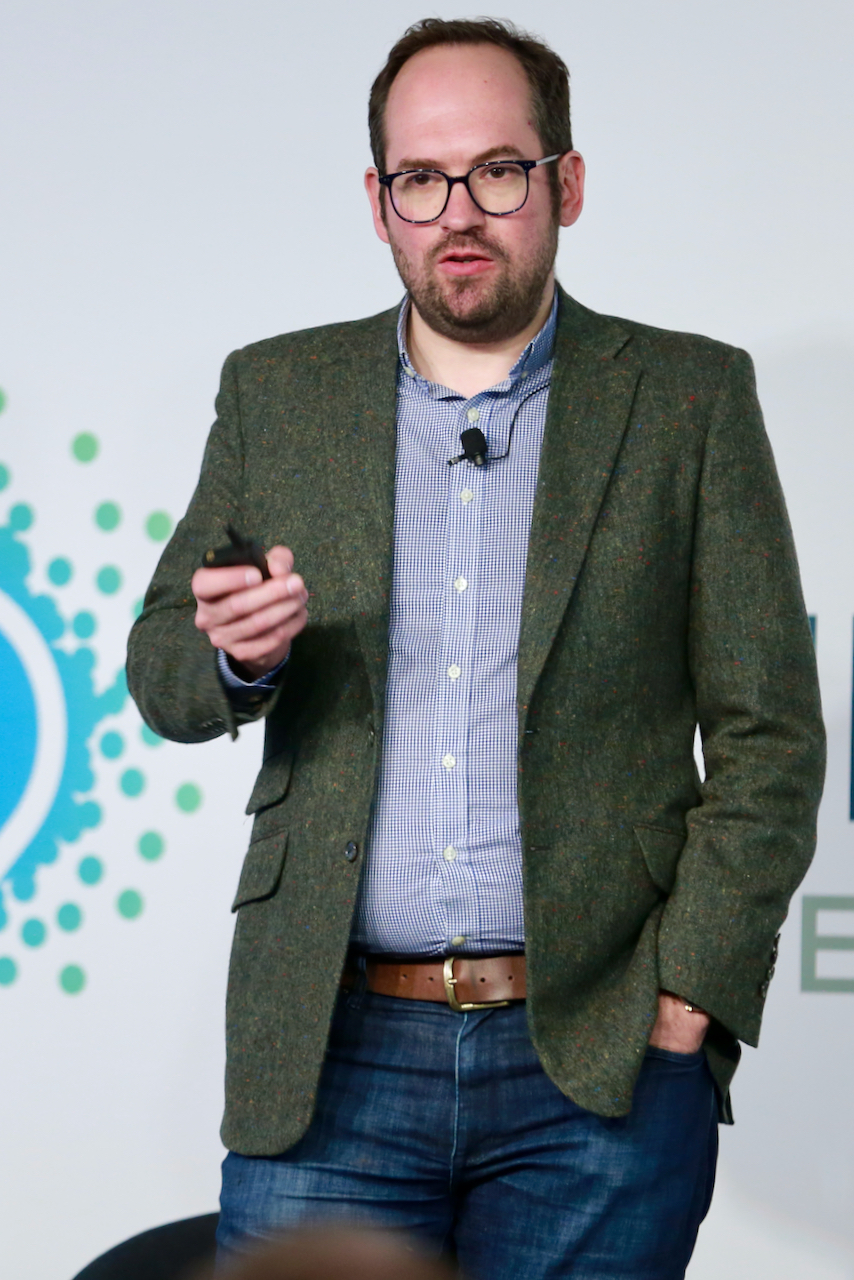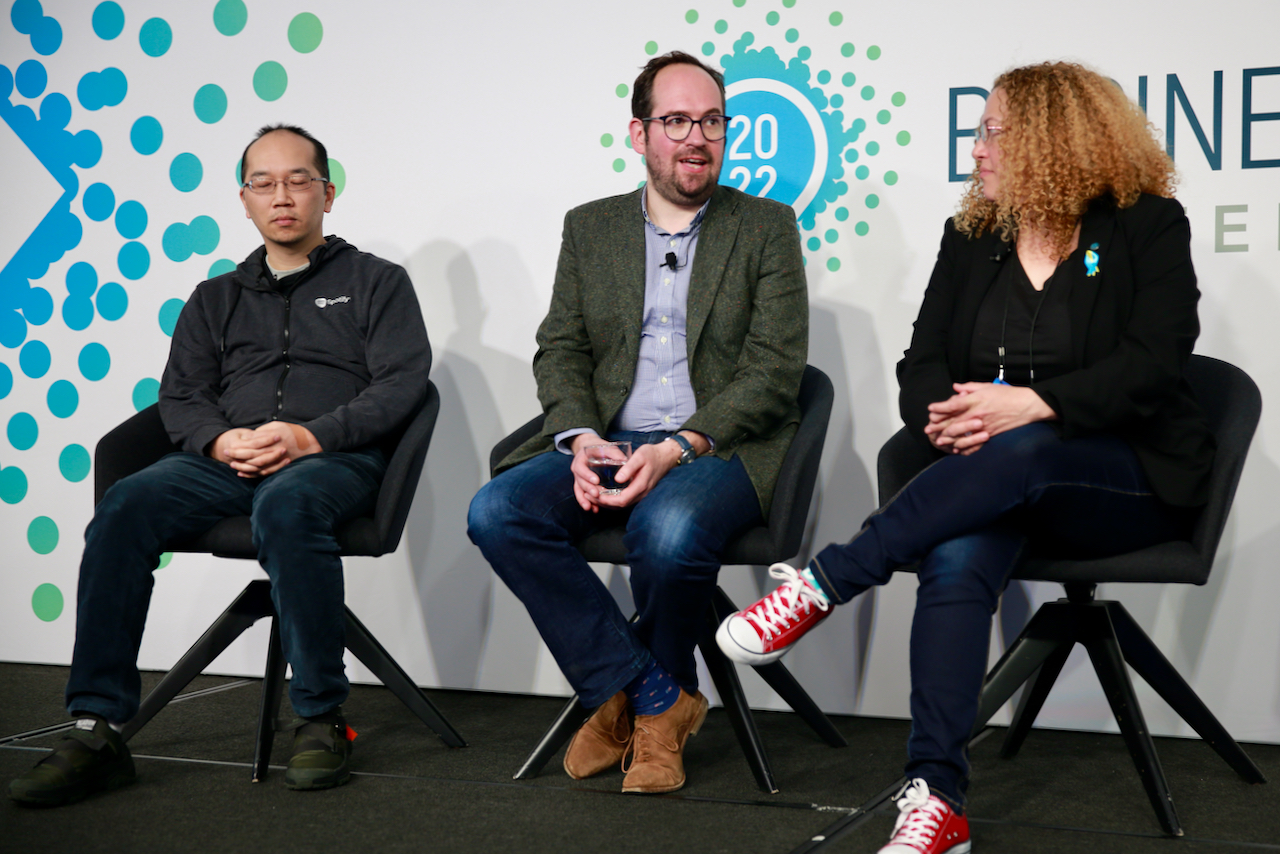Well, I'm not quite sure how to follow that. I'm not running for office. I work for a bank. Making agility relevant. I think this is a topic that we've been discussing quite heavily on our table. It's great to hear about all of the things that people are doing. But it's really about how does that become relevant for our organization, for our customers, and for our senior executives as well. That's what I want to touch upon today. All right? It says here I'm a Director at HSBC. My actual job title is Head of Ways of Working for Securities Services. If I can, is it the green button? -Big green button. -Big green button. Hello, we've got the Gremlins. Yeah, the person before me broke it, exactly. Oh, there we go, right, okay. My actual job title is Head of Ways of Working for Securities Services. I thought about putting an organization chart up, but I decided that that would be too complicated.
HSBC is a gigantabank. I've made that word up. But basically it's 250,000 people across just about any country you can think of, in any continent. We have a lot going on. The olds expression about supertankers comes to mind. I think HSBC is a fleet of supertankers. What we've referenced here is our little super tanker, Securities Services as part of MSS. We'll get onto a little bit about context about what Securities Services is. What it isn't is a provider of door services and bouncers. I have been phoned up and asked that question before. It is to do with finance. But we'll get on a bit of context, and what I want to talk to you about today is how we're making that relevant for our clients, some of the experiments that we've done and some of the outcomes that we've seen.
To do that, I'm going to tell you a story. I'm going to give you some context around the business. I'm going to give you a little brief history of where we got to or what we've been doing over the last few years. I'm going to explain a little bit about the framework that we've been using. Then we're going to have the money slide. We're going to have the slide that tells you all those answers. Then we're probably going to have a bit of an anti-climatic lessons-learnt slide. The reason I say it's anti-climatic is everybody before me has stolen all the lessons that we've learned. There probably won't be anything particularly new up there. But that's also quite reassuring. That's the good thing I'm taking out of this. There we go, we're a super tanker. We are the little rudder on that supertanker of the MSS Securities Services division. What are we?
This is the corporate slide. We effectively supply services to a range of big clients. So asset managers, asset owners, banks, et cetera, et cetera. We essentially provide an outsource operations business... I've just lost that slide there. Outsource operations business, but also a custody business as well. Now, the reason that's interesting is the way in which we drive revenue. We drive revenue from onboarding, basically. We have long-term relationships with our clients, so we have big books of work, we have big projects, we have big programs, and we have long-term engagements with our clients. We're not like the investment bank where we have a very volatile revenue model. We have long term mandates, typically 7-10 years. We're eight and a half thousand people across 37 different countries and we've got global teams. I think it would be, I'm going to go out on a limb and say that every single team that exists in the Securities Services organization has people in multiple locations similarly with our clients. We're always talking cross border cross-country with everything that we do. Our ways of working journey, there we go, Genesis of man, there. We started off like most organizations, with a DevOps transformation technology. We have around about 200 platforms and systems that support our business. There's a whole mix of big monolithic platforms in their vendor platforms, stuff that we've built ourselves, stuff that's older than me, believe it or not, that kind of stuff that's hanging around in our infrastructure.
The DevOps transformation started in technology to really try and streamline that and focus on our ability to deliver and improve our release cadence. We set a couple of OKRs actually around that, around every year, doubling production, having a minor incidents and quartering our major incidents. And that was what the organization focused on. Two years into that transformation, the tech guys were delivering a fantastic job. They'd really really changed our infrastructure and it was now time for the business to start leveraging that. I think anybody that's been on this kind of journey will know that if you get your tech infrastructure sorted first, it actually becomes really responsive to when the business starts demanding things. If you try and do it the other way around, the business starts getting very impatient with the technology function that can't deliver at pace. We did it this way round. A big driver for us there was a strategy refresh from the C-suite of the organization And it was brilliant. Because what that strategy refresh did was set out really clear set of goals. Essentially, we wanted to double the revenue of the organization and we wanted to maintain a flat cost base. Now we went away and we took our bit of paper and we scribbled it down and we worked out that meant we needed to be about 3X more efficient at delivering and executing change in the organization to support that ambition.
Off we went and we decided to then look at agile practices within our change management function. Then the pandemic came along. We won't dwell on that, but suffice to say, what it did was prove a few things. It proved that as an organization we could do things fast. Things like, go from almost 100% in an office environment to more than 95% working from home in a matter of weeks. It proved that we could take an eleven-month program of getting things like Zoom implemented across the organization. We could do that in a matter of days. It proved to our senior execs as well that we didn't have to be perfect at doing that and that was really important. The pandemic proved that we could do stuff at pace and it also gave us some real focus. The operations and the business teams, now we're really able to focus on what was most important, the client, and making sure that we were able to maintain the services that we were being paid for. That progressed and then the back of February 2021, after I came back from shared parental leave, I was asked to set up the Ways of Working functional capability within the COO world.
This was the business taking it out of change management and into the enterprise. We then spent a few weeks locked away in a virtual dark cupboard developing our Ways of Working framework, which I will reveal to much applause, I'm sure, on the next slide. That's what we then started working on. It was really predicated around a few things. I'm ruining the next slide now, but it was really around launching value streams, focusing on flow, and thinking about the culture that we needed to embed to drive agile transformation. In 2022, we are cracking on with that journey. But we've basically got three high-level business outcomes. These are the things that are driving everything that we do. Improving business performance so our CIR, cross income ratio, improving our client satisfaction, and improving our employee engagement. Everything that we do is geared around trying to prove those three outcomes. So here we go. This is the- Thank you. Thank you. You know what, they didn't even do that. They didn't even do that at work when I did this. So thank you for that.
We're looking at this through three lenses. Okay? We want to look at how we organize, how we execute, and how we operate. I put a bit of blurb around there. I've broken number 1 rule of PowerPoint by putting too many words on. But essentially around organization, this is around value stream organization. We're a highly, highly functionalised business. This is 150 years of learned behavior coming together to form what we have right now. The move to value streams is a really important part of this transformation. Focusing on what it is that we do, the things that we provide to our clients and the reason why they pay us. We believe that each value stream has three things it does. Ideation, so thinking of new things, product design, product development, working with clients. Delivery, this is the most painful part of it all.
This is where we get into client onboarding, delivering client change, operational efficiency change, et cetera. And then running it. Actually running and delivering the service in BAU. We then want to focus on flow under execution. There's a lot more to that, but that's basically getting data wrapped around those processes. The last thing around this is the operational piece of the coaching for success. I'm speeding up because there's a big scary clock down here, and I'm rubbish at keeping to time on this. Coaching for success. We've got a three-layer coaching model. Leadership coaching. I believe I'm going to go out on a limb and make a crazy statement that is unverifiable. But I think we're one of the first organizations to have an internal course that allows people to be externally accredited in coaching. I'm going to be an accredited leadership coach any time soon. We want to get some coaching accreditation across the organization. Bring in agile coaching, so specialist targeted coaching for teams. Then what we've called ecosystem managers. These are effectively people that are embedded right within an individual team. We're sort of scaling it up like that. We could do a talk on any one of these three things, but the one I'm going to double click on or Zoom in on is the flow piece. Because this is where we've seen some phenomenal early successes. Back to how you make it relevant. Yet again another complete PowerPoint fail slide. Far too many words on there. But what I've also done is left a few acronyms that you won't understand. You have to listen to me now. Okay? All right.
This team, a bit of context, this team is about 150 people. It's a typical team in Securities Services. It covers four of the functions that deliver. We've got a product team, we've got a delivery team, we've got a technology team, and we've got an operations team. They run front to back. They operate on a vendor system, a vendor platform. It released quarterly. It's a horrible system. It's many years old. And they have a CTB or a change the bank budget or delivery budget around about $11 million in 2019. And this is what they were doing. They were coming out the back of a particularly painful program. I knew it was painful because I'd been given that hospital pass when I came and joined Securities Services. They were coming out of a really low point. What they did was completely refocused the team and they focused on lead time, and lead time became the thing that was guiding their decision-making.
As you can see on the chart there, we've got the gray boxes, which indicate the average lead time per quarter in 2020 and then the red ones in 2021. You can see a significant improvement in lead time over the course of the two years. Relentless focus by the team. It wasn't just accidental, of course. We didn't just say, "Focus on lead time," and boom, suddenly what you got was an improvement. They focused on three things. A lot of the topics you will have heard over the last two days, we've already covered here.
A focus on release cadence, moving from quarterly to daily releases on the platform. This required a lot of effort. It required a lot of business prioritization as well. This is where the multi-skilled and collaboration really comes together. You needed your products teams and you needed your operations teams to buy into the fact that investment was needed at an infrastructure level to be able to drive improvements in release cadence.
Automation in that release process as well. And more than that, just keeping an eye on that as a metric. We were constantly referring back to that metric. Multi-skilled teams. Again, so we've talked a little bit about multi-skilling. We worked really successfully with bringing developers and analysts and project managers together into pods and teams together. They were able to cross-work and teams owned things from front to back. We were not doing the, it's your problem, it's your problem, it's your problem. The over the wall issue.
The last thing was around collaboration as well. This was yet again bringing our four functions together. Lots more we can talk about there, but I am also looking at that clock. But essentially, we did all that through what's called the FSHR dashboard. For anyone that's read Jon Smart's BVSSH book, this is a complete and total rip-off of what he wrote in that book that I've been claiming as my own for the last two or three years. It stands for Faster, Safer, Happier, Right. See, it's even slightly similar. Essentially what it does is it's a dashboard that allows the teams to show how fast, how safe, how happy, and how strategically aligned they are in the deliveries that they're doing. All of this has been going on. What have we seen as a result?
We've seen a collapse in lead times. You can see 113 days down to, that 33 is a blip, to around about 25 days, average per quarter. What have we got now? We've got happier clients. We run a panel of lights dashboard for clients in 2019. It was red, a sea of red. There was not a happy client in sight. We got escalations all over the place. And in fact, actually the delivery lead on this particular team was going in to see our CEO every Friday to explain why. I had to explain that this was not a good meeting that he was going into. This was a bad thing. We've got a sea of green across our clients. Reduced delivery risk, 90% reduction in errors and delivery risk. Two really important things here. The backlog was transitioned away from yesterday and towards tomorrow. So previously, 100% of our backlog was firefighting. Everyone was running around with their hair on fire every week because there was escalations all over the place. 30% to 40% of that backlog now is focused on transitioning that team onto new technology, the future, basically. In fact, this team is likely to become the Genesis of some really interesting new product conversations around how we commercialize our data. And reduced and more stable investment spend.
This is what got our CFO really interested, was our CTB spend has gone down from 11 million in this team to around about four and a half. But it's been stable. This team also never comes to the begging bowl process that we have every year asking for more money, because it manages through the capacity that it has. We've now got a massively reduced, much more stable investment spend, which makes our internal business happy. We've got much happier clients and we're now able to see how this team will start developing and thinking about the future. What have I learned? This is the anti-climax slide. This is the stuff that everyone's already said.
But the four things I've taken away from this, the business has to care. Agility is not a goal in itself. You want to focus on what's important. We won, or we are winning, when we focus on those business results; that investment spend, that stability, that delivery of value to our client. External network. Help is available. This is available. I can't count how many times I've had excellent conversations with people who might be in this room today around, is this the most sensible thing that we're doing? Am I doing this right? Fresh thinking, fresh ideas are really important. You are not alone in this. How do you change successful people? We touched on this very briefly on our table. You're trying to change a culture which has been built on decades of operating in the same way and people have been rewarded for that. And you're now saying, well, actually, you should do it differently. That's really hard. You have to prove that out and trust, trust, trust. This was my lesson.
Some of my biggest allies were people I didn't expect it to be. In fact, actually, my own prejudices meant that when I sat down and did my little heat map, I thought, okay, well, you're going to be a problem. They've turned out to be some of the biggest advocates for this. So hands up for me, I got that wrong. Be open minded, invite people in to have that conversation.
It says zero, so I've overrun. But thank you very much for listening. It was a bit of a whistle-stop tour, but happy to have any questions later.






